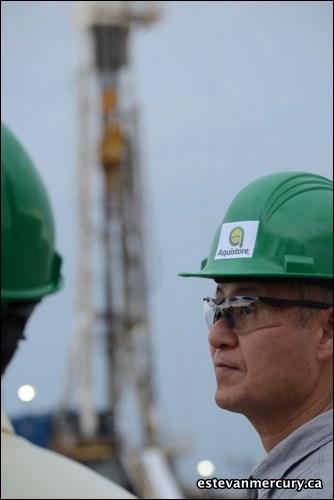With most of the industrial activity around Estevan centring on coal mining and oil drilling, residents of the southeast are used to depending on what's under their feet.
The Aquistore project takes that dependence to a new sub-level, as researchers at the Petroleum Technology Research Centre (PTRC) complete their work, which is expected to lead to a storage facility for carbon dioxide more than three kilometres below ground.
An open house was held July 24 at the drill site for media, local dignitaries and observers from Japan, South Korea and South Africa, who received tours of the active drilling rig and information on the project.
The project's crew is drilling the evaluation well at a rate of roughly 11 metres every hour. Drilling will take 40 days and be complete in a few weeks. Shortly afterward, they will be drilling the observation well.
The Aquistore project is being done in conjunction with construction of the carbon capture facility currently underway at Boundary Dam Power Station's Unit 3. Once it becomes active in early 2014, the captured carbon will be sent via a pipeline a few kilometres west of the power station and into a layer of sandstone.
What the PTRC is depending on is that the rock formation they will be injecting the liquefied CO2 into holds the carbon, while the thick layer of shale above it acts as a lid, preventing any of the CO2 from escaping back up to the surface.
Erik Nickel, senior project manager with the PTRC and geologist on the Aquistore project, said there are two layers of sandstone from the Winnipeg formation and the Deadwood formation they will be injecting the CO2 into.
"Those two act as the container," he added, noting the shale in the Winnipeg formation sits just above and acts as the "shield."
The layer of shale is between 60 and 100 metres thick.
A province-wide poll released in July by International Performance Assessment Centre showed that 43 per cent of people would be concerned by a project like this implemented within five kilometers of their home. The concern may come from perceived environmental risks if the carbon were to seep through the cracks and reach the surface through the multiple layers of rock.
Nickel said that isn't an issue, saying the shale is a sufficient cap, and they have done tests to prove that point.
Nickel said they have taken samples of the geochemicals in the different layers of rock beneath the ground. Their tests have shown the water in the different layers has not been mixed, demonstrating that liquids in the porous rock layers are not seeping through the hard shale layers.
Nickel demonstrated further by spraying water on a few rock samples at the drill site. When he sprayed the sandstone, the water penetrated the rock, entering the little pores between the grains and leaving the rock dry. The CO2 will be stored inside the sandstone in the same manner.
When he sprayed the shale sample, the rock rejected the water, which flowed and dripped off the surface.
If a leak did occur, he said it would more likely be through an old oil well that wasn't properly cemented and sealed.
Project leader Malcolm Wilson noted the importance of the tests they will be running. Later this year the PTRC will be testing the storage process by injecting food-grade CO2 into the sandstone so they can monitor the plumb, how the CO2 flows through the rock, and whether or not there are any leaks.
"The bottom line for us is demonstrating integrity of storage," said Wilson.




